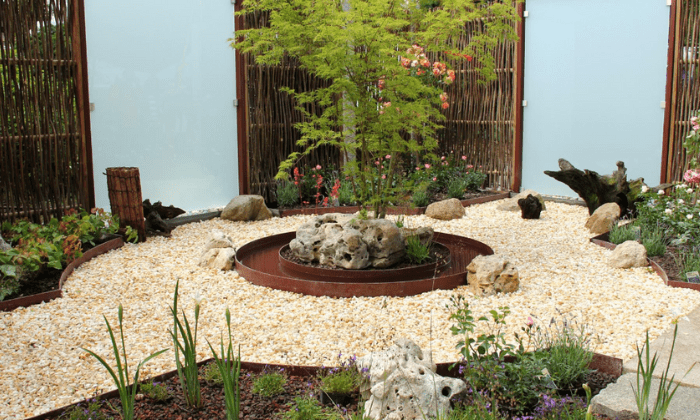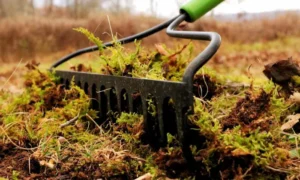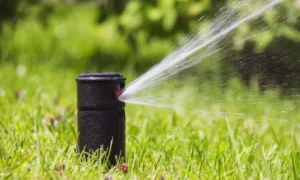
Low Maintenance Front Yard Landscaping Tips and Ideas
Low Maintenance front yard landscaping plays a crucial role in enhancing the overall aesthetic appeal of a property while also serving functional purposes. It’s often
In the realm of innovative landscaping solutions, Robert Complete Care has emerged as a leading provider. With a passion for transforming outdoor spaces into stunning, eco-friendly landscapes, Robert Complete Care specializes in front yard landscaping designs that go beyond the conventional grass-centered approach. Their team of skilled professionals is committed to delivering creative and sustainable solutions that align with each client’s preferences and the unique characteristics of their property. Whether it’s incorporating native plants, installing captivating hardscapes, or implementing water-efficient designs, Robert Complete Care is dedicated to crafting front yard landscapes that are not only visually captivating but also environmentally responsible.

Opting for a landscaping design without grass significantly reduces the amount of maintenance required to upkeep the front yard. Traditional lawns demand regular mowing, fertilizing, and weed control, all of which can be time-consuming and resource-intensive. By eliminating grass and incorporating rocks and other low-maintenance elements, homeowners can enjoy a more relaxed outdoor environment. With fewer demands for trimming and upkeep, individuals have more time to appreciate their front yard rather than constantly tending to it.
One of the most compelling advantages of landscaping with rocks and without grass is the notable reduction in water consumption. Traditional lawns necessitate substantial watering to maintain their lush appearance, contributing to water waste, especially in regions with water scarcity. Rock-based landscapes, on the other hand, require minimal to no irrigation. By substituting grass with rocks and drought-resistant plants, homeowners can contribute to water conservation efforts, decrease their water bills, and promote more sustainable water usage practices.
Rocks offer a versatile and contemporary aesthetic that can significantly enhance the visual appeal of a front yard. The textures, colors, and shapes of rocks create a dynamic and modern look that stands out from traditional grass landscapes. Whether using decorative gravel, boulders, or natural stone pathways, the incorporation of rocks adds a sense of uniqueness and character to the outdoor space. This aesthetic appeal not only reflects the homeowner’s style but also boosts the overall curb appeal of the property, making it more inviting and visually striking.
Incorporating rocks and eliminating grass from front yard landscaping presents a plethora of benefits, including reduced maintenance demands, water conservation, and a distinctive aesthetic. These advantages collectively contribute to a more sustainable, visually pleasing, and enjoyable outdoor space that aligns with modern homeowners’ preferences and environmental concerns.
Before embarking on a rock-based front yard landscaping project, it’s essential to assess the size, layout, and existing features of the space. Take note of the dimensions of your front yard, including any slopes, existing vegetation, and structures like walkways and driveways. This assessment will help you determine the optimal locations for different rock elements and ensure that your design integrates harmoniously with the existing features.
Selecting the appropriate types, sizes, and colors of rocks is crucial for achieving your desired aesthetic and functionality. There are various options available, such as decorative gravel, river rocks, boulders, and natural stones. Consider factors like the overall theme you want to achieve (modern, rustic, etc.), the color palette that complements your home’s exterior, and the sizes that work well with the scale of your front yard. Mixing different types of rocks can add texture and visual interest to the landscape.
Rocks can be used creatively to design functional and visually appealing pathways in your front yard. Lay down a foundation of compacted gravel or sand and then arrange flat or irregularly shaped rocks to form the pathway. This not only guides visitors through the space but also adds an inviting element to your landscaping. Incorporating curves and gentle turns can enhance the natural flow of the pathway and create a more engaging experience.
Larger rocks can serve as captivating focal points in your front yard design. Consider using boulders or larger decorative stones strategically placed to draw the eye and add visual interest. These focal points can anchor different areas of your landscape, whether it’s near the entrance, along a pathway, or nestled within a garden bed. You can also complement these rocks with smaller plants, decorative elements, or outdoor lighting to enhance their impact.
When designing your front yard with rocks, remember to balance functionality and aesthetics. By assessing the space, choosing rocks thoughtfully, creating pathways, and incorporating focal points, you can create a visually stunning and functional landscape that reflects your personal style while minimizing maintenance and water requirements.
When opting for a rock-based front yard landscaping design, choosing drought-resistant plants that thrive in rocky environments is crucial. Some excellent choices include:
To create visually appealing plant clusters, consider grouping plants with similar water and sunlight needs. This technique maximizes the efficiency of irrigation and creates cohesive, harmonious plant arrangements. Varying the height, texture, and color of plants within each cluster adds depth and interest to the landscape. Additionally, placing plants closer to rocks can create a more naturalistic appearance, mimicking the way plants might naturally grow in rocky environments.
Xeriscaping is a landscaping approach that focuses on water-efficient design, particularly important in arid or water-scarce regions. The principles of xeriscaping include:
By embracing xeriscaping principles and carefully selecting desert plants, you can create a front yard landscape that not only conserves water but also showcases the beauty of arid-adapted flora in harmony with rocks and other design elements.
Japanese Rock Garden: The Japanese rock garden, also known as a “karesansui” or “zen garden,” embodies minimalist and tranquil design principles. This style seeks to capture the essence of nature in a controlled and symbolic manner. Typically, a Japanese rock garden features meticulously raked gravel or sand, which represents water or waves, and carefully placed rocks that symbolize mountains or islands. This design encourages contemplation and meditation, with visitors often using wooden rakes to create patterns in the sand. The simplicity of the design, combined with the careful placement of rocks, evokes a sense of calm, balance, and serenity, making it a perfect choice for those seeking a tranquil oasis in their front yard.
The Mediterranean rock garden draws inspiration from the landscapes of Southern Europe, particularly regions with dry and sunny climates. This style often incorporates a variety of drought-resistant plants, including succulents, herbs, and aromatic plants. Lavender, rosemary, thyme, and sage are commonly used to create a fragrant and visually appealing garden. The use of earthy tones in both the rocks and plants reflects the warm and inviting ambiance of Mediterranean landscapes. This design is not only aesthetically pleasing but also practical, as it thrives in arid conditions and requires minimal water.
Creating a desert oasis-themed rock garden involves blending elements of lushness and vibrant color with the arid aesthetics of desert landscapes. To achieve this, use a mix of drought-resistant plants, such as succulents, cacti, and vibrant flowering plants. Select rocks of varying sizes and shapes to mimic the natural diversity found in desert environments. Incorporate features like a dry riverbed or a decorative water feature to capture the oasis vibe while conserving water. The juxtaposition of rocks, sand, and bursts of color from flowers creates a visually striking and inviting front yard, evoking the essence of an oasis in the midst of a desert.
Each rock garden arrangement offers a unique and captivating way to enhance your front yard. Whether you’re drawn to the tranquility of a Japanese rock garden, the aromatic charm of a Mediterranean landscape, or the allure of a desert oasis, these designs allow you to create a distinctive outdoor space that reflects your style preferences and the natural beauty of your surroundings.
Decorative stone walls or boundaries can add a touch of elegance and structure to your front yard. To build a stone wall, follow these steps:
Incorporating artistic rock sculptures can serve as eye-catching focal points in your front yard. To create rock sculptures:
Creating rock-based seating areas adds functionality and aesthetics to your front yard. Here’s how to do it:
By incorporating stone walls, artistic rock sculptures, and rock-based seating areas, you can infuse your front yard with unique design elements that add both functionality and visual appeal. These hardscaping features can complement your choice of plants and rocks, resulting in a harmonious and inviting outdoor space.
Maintaining a weed-free rock landscape requires regular attention. Here’s how to keep weeds at bay:
Over time, rocks can accumulate dirt, debris, and algae. To maintain their appearance:
Proper care of the plants in your rock landscape ensures their health and longevity:
By following these maintenance tips for your rock landscape, you can enjoy a well-kept and visually appealing outdoor space that continues to thrive over time. Regular care ensures that both the rock features and the plants remain in their best condition, contributing to the overall beauty and functionality of your front yard.
Incorporating solar-powered lights into your rock landscape is a fantastic way to enhance the ambiance and extend the usability of your outdoor space, especially during evenings. Here’s how to make the most of solar lighting:
Solar lighting not only enhances the aesthetics of your front yard but also reduces energy consumption and provides a sustainable lighting solution.
Adding decorative elements like pebble mosaics can bring a personalized and artistic touch to your rock landscape:
By introducing solar lighting and ornamental features, you can elevate the aesthetics of your rock landscape, creating an enchanting and inviting outdoor space that’s enjoyable both day and night. These accents add a touch of personality and creativity while complementing the natural elements of your front yard.
Taking on a rock landscape project can be a rewarding DIY endeavor, but it’s important to honestly evaluate your skills and resources before deciding. Consider the following factors:
While DIY can be rewarding, there are situations where seeking professional help is the wisest choice:
Ultimately, the decision to undertake a DIY project or hire professionals depends on your comfort level, time availability, budget, and the complexity of the project. It’s wise to strike a balance between what you can realistically handle and when expert assistance can provide the best results.
Robert Complete Care is a distinguished provider of comprehensive landscaping solutions that cater to both residential and commercial clients. With a deep commitment to transforming outdoor spaces into stunning, sustainable landscapes, they offer a wide range of services that include landscape design, installation, maintenance, and more. The company takes pride in its ability to tailor each project to the client’s unique vision, ensuring that every front yard reflects the perfect blend of aesthetics, functionality, and environmental responsibility.
In summary, front yard landscaping with rocks and no grass offers a multitude of benefits. By eliminating traditional grass lawns, homeowners can enjoy reduced maintenance efforts, conserve water through drought-resistant plant choices and xeriscaping techniques, and achieve a unique aesthetic appeal through the use of rocks, plants, and artistic elements. These rock-based landscapes provide an opportunity to create serene and visually stunning environments while contributing to sustainability efforts.
In summary, front yard landscaping with rocks and no grass offers a multitude of benefits. By eliminating traditional grass lawns, homeowners can enjoy reduced maintenance efforts, conserve water through drought-resistant plant choices and xeriscaping techniques, and achieve a unique aesthetic appeal through the use of rocks, plants, and artistic elements. These rock-based landscapes provide an opportunity to create serene and visually stunning environments while contributing to sustainability efforts. If you have any questions or concerns, please don’t hesitate to contact us.
What Are Some Benefits of Using Rocks Instead of Grass in My Front Yard Landscaping?
Using rocks in your front yard landscaping offers several benefits, including reduced maintenance, water conservation, improved drainage, and a unique visual appeal. Rocks require less upkeep compared to grass, and they can withstand various weather conditions without the need for constant mowing and watering.
What Types of Rocks Can I Use for My Front Yard Landscaping?
There are various types of rocks you can use, such as river rocks, gravel, pebbles, boulders, flagstone, and crushed granite. Your choice will depend on the desired aesthetic, local availability, and the overall theme you want to create.
How Can I Incorporate Plants into a Rock-Based Front Yard Landscape?
You can incorporate plants by creating rock garden beds and planting drought-tolerant succulents, ornamental grasses, native plants, or low-maintenance shrubs. Use the rocks as borders and accents around the plantings to create an attractive contrast.
Will a Rock-Based Landscape Attract Pests?
Rocks alone are less likely to attract pests compared to grass. However, it’s important to keep the area tidy, remove debris, and control weeds to prevent potential hiding places for pests. Regular maintenance will help mitigate any pest concerns.
How Can I Prevent Erosion in a Front Yard with Rocks and No Grass?
To prevent erosion, you can strategically place larger rocks or boulders to act as natural barriers and retain soil. Additionally, using ground cover plants or mulch in between the rocks can help stabilize the soil and minimize erosion.
Are There Any Eco-Friendly Benefits to a Rock-Focused Front Yard?
Yes, using rocks in your front yard landscaping can be eco-friendly. It reduces water consumption since rocks require less irrigation than grass. Additionally, using native plants alongside the rocks can support local wildlife and pollinators.
Can I Create Pathways or Walkways Using Rocks in My Front Yard?
Absolutely! Rocks can be used to create visually appealing pathways or walkways in your front yard. Consider using flagstones, gravel, or stepping stones to define pathways that lead to your entrance or other areas of interest.
How Do I Maintain a Rock-Based Front Yard Landscape?
Maintenance is relatively low compared to a traditional grass lawn. You’ll need to periodically remove debris, weeds, and fallen leaves from the rock beds. Trimming and pruning plants, if included, will also be required. Additionally, consider replenishing the rock layer if it becomes uneven over time.
Can I Incorporate Decorative Elements into a Rock-Focused Landscape?
Absolutely! Rocks provide a versatile canvas for adding decorative elements. You can include outdoor sculptures, decorative lighting, benches, or even a small water feature to enhance the visual appeal of your front yard.
Should I Consult a Professional for Designing My Rock-Based Front Yard?
If you’re unsure about the design, plant selection, or layout, consulting a professional landscaper or landscape designer can be beneficial. They can help you create a cohesive and visually appealing front yard that aligns with your preferences and the overall aesthetics of your home.

Low Maintenance front yard landscaping plays a crucial role in enhancing the overall aesthetic appeal of a property while also serving functional purposes. It’s often

How to get rid of moss in your lawn can be a persistent problem, often appearing as a dense, green carpet that outcompetes grass for

Lawn fungus represents a significant challenge for homeowners and landscape professionals, impacting the aesthetic and health of lawns. These fungal infections can manifest as unsightly

Best time to water lawn and maintaining a lush, green lawn often involves more than just regular mowing. One crucial aspect of lawn care is

Ensuring optimal grass growth is crucial for maintaining a lush and healthy lawn. One of the key factors in achieving this is using the right

In the bustling metropolis of the sprinkler repair los angeles, where the sun shines almost year-round and the risk of fires is a constant concern,

Robert’s Complete Care has a proven track record of providing creative, high-quality lawn care Whittier services, CA area.
Copyright © 2023. All rights reserved Robert's Complete Care | Powered by Localpro1.